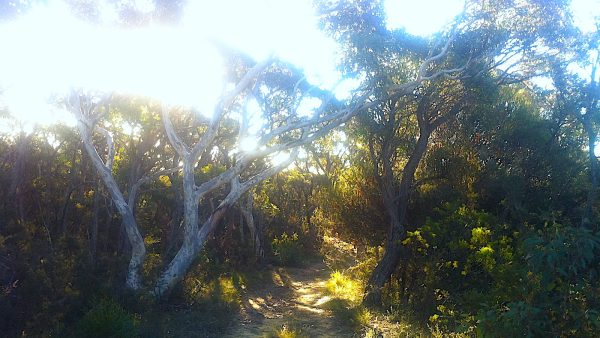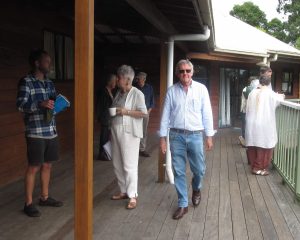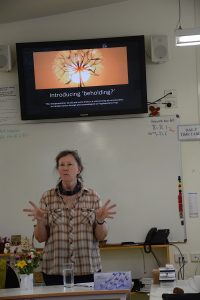
A Report on the 2nd Etheric Geography Conference
Linuwel Steiner School, March 11-13, 2022
Unlike the astral world, which I can easily think about and experience in my daily thoughts and feelings (being of the same substance), the etheric world seems quite mysterious. Largely unconscious or subconscious processes within us, life energy, formative forces relating to the various elements, elemental beings, the human etheric body, the etheric body of the Earth – it’s a vast esoteric subject. This conference attracted me with its offer of experiential ways to meet and get to know the etheric in ourselves and our environment. And I wasn’t disappointed.
It felt great just to be able to come together, of course. In spite of some flooding in the Hunter Valley, 20 participants and a team of a dozen or so volunteers and presenters convened at the Linuwel School at East Maitland for a stimulating and congenial weekend’s learning.
 This NSW Branch event was presented by the Stream of Life Research Studio (SoLRS) in alphabetical order: Fiona Campbell, Irmhild Kleinhenz, and Martin Neeme-Samson, joined by local eurythmist Gudrun Ludescher. It was supported by the participants from Hunter Valley anthroposophical communities, Linuwel School, Shepherd’s Ground Farm and Village, Purple Pear Farm and Newcastle Steiner School. The organisers and presenters harmonised theory and practice extremely well, clearly the fruit of all of these groups working and growing together over time.
This NSW Branch event was presented by the Stream of Life Research Studio (SoLRS) in alphabetical order: Fiona Campbell, Irmhild Kleinhenz, and Martin Neeme-Samson, joined by local eurythmist Gudrun Ludescher. It was supported by the participants from Hunter Valley anthroposophical communities, Linuwel School, Shepherd’s Ground Farm and Village, Purple Pear Farm and Newcastle Steiner School. The organisers and presenters harmonised theory and practice extremely well, clearly the fruit of all of these groups working and growing together over time.
The venue was perfect for our Conference. Linuwel School is very green, extensive and built around a large waterhole, which had a huge presence, much swollen by the recent rains.
Elements of etheric geography
In his talk, Martin created a picture of how Indigenous soul-spiritual knowledge and practices – using the “three Ls: Look, Listen, Learn’ – harmonise with spiritual scientific (and physical scientific) approaches, particularly Goethean phenomenology1, as researched by the SoLRS. The goal of creating a new ‘third way’ of understanding and working with the etheric in the ‘landscape temples’ below, above and around us, and especially with the watery element2 was suggested as a real possibility for the future- starting this weekend!
Highlights of the next day and a half included the early morning eurythmy sessions with Gudrun, in which groups of five people moved across the floor in patterns of a 5-pointed star (the shape of our ‘etheric skeleton’, according to Steiner3) to a verse by Rudolf Steiner:
Steadfastly I take my place on earth
Certain as I walk through life
Love in the core of my being
Hope in all I do
Trust in all my thinking
These five take me to my goal.
These five give me life on earth4.
Slowing down to the speed of Nature

Fiona’s talk and slideshow introduced us to ways of using our senses differently, using the Goethean ‘participatory’ approach to beholding phenomena in nature but also in art and human interactions. We were taught ways of ‘soft looking’ at a found natural object using a relaxed gaze, allowing the eye to reach out like a hand (the ‘eye-hand’) to surround and explore the object, gently, like a caress. Our imagination rather than our intellect added the invisible details. We were given plenty of time for this preparation. Then we drew our object and wrote about the experience.
My object was a peach seed I had found lying under a peach tree in the school yard. Here’s what I wrote:
‘The peach seed drew my admiration. Hard texture, shaped like a pregnant heart, wave patterns, one end pointy, one rounded, perfectly designed to find the earth and earth to find its way into its little holes, concavities.’
When asked to close our eyes and take the image inwards, I experienced it as a warm, flame-like presence in my heart. This resonated with the Rilke’s words that Fiona quoted:
Through all beings stretches the one space:
World-innerspace. The birds fly quietly
through us. Oh, I who wish to grow,
I look out, and inside me the tree grows.
Rainer Maria Rilke, Sämt. W, 2:93
Dowsing: a tool for ‘reading the etheric’
On Saturday afternoon, some folk continued with Fiona to deepen their experience by beholding, and later drawing from memory, a small pocket of the watery landscape, again with lots of time to sit, ‘look, listen and learn’ from the living subject of study. I gathered later that this was very rewarding, but I chose to join Martin’s practical dowsing group. I had been taught dowsing with a pendulum in the past but was never satisfied as to the accuracy or source of the yes/no answers to questions I asked with it. This time, we learned to use a dowsing rod (made from metal coat hanger-very affordable!) which reacted easily and visibly to the energy of the environment (room, people, trees, watercourses, whatever), whether we stood still or moved around, allowing for lots of experimentation.
In this way, we were able to confirm Martin’s descriptions ourselves. It was fascinating, for example, to see the difference in the ‘energy orbit’ of a large, healthy tree with plenty of space around it, compared to one with a gravel car park encroaching on its roots. This was noticed by Irmhild who then, under Martin’s guidance, engaged in a process of what the Indigenous Knowers call ‘Sorry Business’: asking what the tree wants from us to help it heal, even if we can’t undo the carpark. As a consequence, one of the Linuwel community members present resolved to embark on that task with the help of the school’s gardeners. Obviously there is much more Sorry Business to be done all around us. Dowsing is something simple but powerful that we can do for the future, rather than just be destroyers of landscape temples, because of our lifestyles.
Healing Ourselves
Irmhild’s talk on Saturday evening illustrated how we can contribute positively to our own and others’ healing from illness by changing our attitudes to disease, pain and suffering generally. The positive effects of meditation are, of course, well known, but anthroposophic medicine suggests that doing the rückschau (reviewing the important events of the day in backward order) before sleep allows the etheric body to healthily wash away what Steiner called ‘brain sand’ as we lie in the horizontal position – those myriad sense impressions which are like footprints on the beach.
I think we’ve all experienced the reality that our healthy etheric can influence the etheric of another person. And the positive power of forgetting one’s pain or symptoms for a while by focusing on something else: for example, in a friendly study group, which adds the healing thoughts of Anthroposophy to the mix. Last but not least, when our thoughts and feelings are focused on love and service to others, rather than fear, blame, hatred and resentment, disease and illness find it much harder to invade our inner eco-systems.
Closing Song
Closing the conference on Sunday afternoon, Deborah Saffir led us in this healing song:
I am with you so I can heal
You are with me so you can heal
We are together so we can heal
We are healing so we can love.
Thank you to the organisers, presenters and volunteers for a memorable conference.
Joanne Strauss
1. Defined as:“The study of structures of consciousness as experienced from the first-person point of view.” https://plato.stanford.edu/entries/phenomenology/
2. The 1st Etheric Geography Conference and a webinar had looked at the fire and air elements.
3. in Esoteric lessons 1904-1909, Lesson 09, November 1906, Pg 137-138, CW266/1
4. Interestingly, our local study group had just discovered this verse in the Guidance in Esoteric Training book, p57.
Recommended Readings
On Indigenous culture
Bradley, J., 2010. ‘How Aboriginal dance and song connects with earth energies’ in Singing Saltwater Country : Journey to the Songlines of Carpentaria, Allen and Unwin.
Kassler J.C. & Stubbington, J., 1984. ‘Aboriginal Music’ in Problems and solutions: occasional essays in musicology presented to Alice M. Moyle, (ed.) Hale & Iremonger, Sydney.
Neale, M. and Kelly, L., 2020. Songlines: The power and promise. Thames & Hudson Australia.
Whale Dreamers, 2006. Documentary.
On Goethean Science
Schwenk, T., 1996. Sensitive Chaos: The creation of flowing forms in water and air. Rudolf Steiner Press.
Bortoft, H., 1996. The Wholeness of Nature: Goethe’s Way toward a Science of Conscious Participation in Nature, Hudson, NY: Lindisfarne.
Bortoft, H., 2012. Taking appearance seriously: The dynamic way of seeing in Goethe and European thought. Floris Books.
On Anthroposophic medicine:
Steiner, R., 1923. Supersensible Knowledge (Anthroposophy) as a Demand of the Age. New York: Anthropo-sophic Press, Inc., 19/p3. GA 55.
Steiner, R.1984. Therapeutic Insights: Earthly and Cosmic Laws: Five Lectures, Dornach, June 24-July 3, 1921. Mercury Press. GA 205
Girke, M 2016, Internal Medicine: Foundations and Therapeutic Concepts of Anthroposophic Medicine. Salumed-Verlag.
Photo credit: courtesy of Fiona Campbell and Mark Gallagher